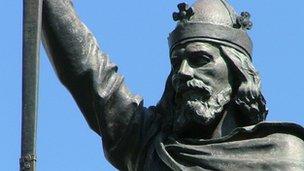'King Alfred' remains in Winchester to be examined
- Published

King Alfred, who died in 899, is the only English monarch known as "The Great"
Permission has been granted to see if remains from an unmarked grave are those of King Alfred the Great.
The remains at St Bartholomew's Church, Winchester, were exhumed amid security fears after publicity surrounding the discovery of Richard III's remains.
The local Hyde900 group, external has been successful in its application and will start scientific tests shortly.
The chancellor of the Diocese of Winchester gave permission after a consultation.
He has granted the group a licence - known as a faculty - to start examining the remains.
In a statement, the diocese said: "This decision has been made independently of the Diocese of Winchester and takes into account the views of a number of statutory consultative bodies, such as the Church Buildings Council.
"Hyde900 will now have the responsibility to manage any scientific investigations, complying fully with any conditions set out by the chancellor."
The Hyde900 community group was set up to celebrate the 900th anniversary in 2010 of the foundation of Hyde Abbey, the burial place of King Alfred.
Rosemary Burns, executive committee member, said the group was working with a number of experts who were "ready to go" but said she could not reveal more details because of a confidentiality agreement.
She said it was likely invasive samples would be taken for carbon dating as well as isotope and oxygen analysis which could show where the person was born, brought up and even what that person ate.
Ms Burns said DNA testing, which was used to identify Richard III's remains found underneath a Leicester car park, could be an option but finding a descendant of Alfred would be trickier as he died almost 600 years earlier.
Dr Katie Tucker, from the University of Winchester, has previously told BBC News that dating the remains, which consist of five skulls and some bones, will be crucial.
She said if they are from around the 10th Century it is "proof" they belong to Alfred and his family because Hyde Abbey was not built until the 12th Century and there are no other reasons for any remains from that period to be there.
The abbey was destroyed in 1539 but the church building on the site, St Bartholomew's, survived.
- Published6 August 2013
- Published26 March 2013
- Published5 February 2013
- Published4 February 2013
- Published14 September 2012